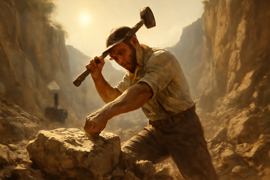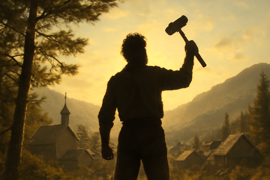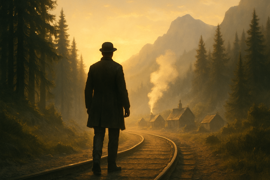Introduction
In the quiet dawn before the sawmill’s whistle pierced the blue haze, John Henry stood barefoot on a narrow track of ballast and iron. His shoulders curved under the weight of a heavy drill, each breath a promise, each heartbeat a hammer. The rising sun lit the dew on worn timbers like flecks of silver, and the distant mountains echoed back his pulse. Word had spread: a steam-powered hammer, cold and mechanical, was coming to test the strength of the greatest steel-driver. Men crowded on the rocky ridges, faces lined with expectation and fear. Steam hissed across the valley as engineers in black boots and linen coats primed the machine, the roar of gears promising a challenge no man had ever met. Yet none shook at the sight of that iron behemoth like John Henry. He flexed his massive arms, sinews uncoiling, shadowed by the uncertain light of morning. The air tasted of pine resin and sweat. In that tense moment before competition, John Henry whispered to himself with calm certainty: he belonged to these mountains, to the rhythm of the drill and the song it rang against the earth. He belonged to the heartbeat of labor itself, a living instrument destined to outplay any engine forged by fire and steam. With the first clang of warning, he drove his drill into solid rock. Sparks flew, answer after answer, man racing machine in a fierce dialogue between flesh and iron.
The Birth of a Legend
John Henry’s story begins in the hollows where the first rails cut into rocky mountainsides. From childhood, he learned to swing a hammer with unerring precision, splitting wood as easily as most men breathed. In smoky lumber camps he worked alongside seasoned timber cutters whose axes glanced off the trunks in rhythmic harmony, yet none matched the power hidden in his lithe frame. When the railroad companies first set their sights on the great ridges of the Allegheny and the Blue Ridge, they hired men by the thousands to pierce the stone. Each laborer staked a claim to a stretch of track, marking territory with iron spikes and elbow grease. But when John Henry arrived, the legend’s forge already glowed. He carried a custom-made drill, its steel bit polished to a keen edge under his careful hands. With each blow of his hammer he could carve crisply through hard shale, faster than six men combined. News of his unmatched pace traveled ahead of him down the valley trails. Camps that had known only the steady beat of picks and shovels now cowered under the thunderous echo of John Henry’s rhythm. Engineers came to watch him drive spike after spike as if his hammer spoke a language of its own—one that resonated deep in the marrow of every man who toiled there. They spoke in hushed tones: “He’s framed by iron and lived in fire.” The old foreman, bent with age, would nod solemnly and say, “When John Henry drives steel, he’s more machine than man.” Yet he laughed to himself, knowing this young hero poured every ounce of his living spirit into each strike, for it was his heart that guided the tool, not cold pistons or steam valves. And so the tale grew in every campfire’s glow, carried on the wind that rattled the rails before the first locomotive ever sang its metal song across the land.

Rhythms on the Rail
As the contest approached, the railroad company hauled their prized asset to the mountain gap: a steam-powered hammer whose iron piston knocked rhythmically against a spike. Men gathered to witness whether flesh could outrun steel. On one side stood John Henry, the hammer of justice and perseverance resting in his calloused grip; on the other, the gleaming engine, smoke curling upward as gears churned. When the whistle blew, the first stroke roared through the stands. Steel met stone, an explosive report heard for miles. John Henry’s hammer rose and fell in counterpoint, the click of driver and the whoosh of exhaust forming a peculiar duet. With each blow, he felt the wood handle tremble in his palm, but his resolve only deepened. He sung under his breath—an old tune from the mountain hollows—each line mapping the stony seam he chipped at. Rhythm wasn’t just in his muscles: it was in his soul. Deep within that groove, every grain of rock answered his rhythm with a shower of sparks. Around him, the crowd’s breath caught as the tempo sped. Engines back at basecamp strained, but John Henry never slowed. Spine straight, gaze unwavering, he embodied the very idea of perseverance. Hours passed like minutes. When the sun curled beyond the ridge’s edge, men felt tired simply from watching. The machine’s hammer slowed, pistons rattling in protest. But John Henry tapped on, lungs burning with every inhale, knowing that to give up now was to abandon not just his pride but the promise held in the iron rails beneath his feet—promise of connection, of progress, of the human story laid down like ties across the wilderness. When the final spur fell into place, no whistle sounded: only silence, broken by the distant sigh of steam cleaving the sky. Then, a single cry rose, swelling until the mountains themselves seemed to applaud. And so the railroad tale was sealed: man’s heartbeat strong enough to outlast the pulse of any engine.

The Final Hammer Strike
Exhausted arms trembled, but John Henry dug deep into the well of his spirit. Echoes of that final contest still rang in memory: the razor edge between victory and defeat, the taste of dust in his mouth, the hammer’s head pounding like a drum in his chest. The crowd leaned forward, breath held, as he labored beneath the smoky dawn. Beyond the iron beast, no pistons moved now—its challenge spent. All eyes fixed on his figure alone, sweat-slicked and unwavering. Each swing felt drawn from some ancient fount of resolve, as though his very name called him onward. The timber sleepers beneath his boots seemed to pulse along with him, wrapped in the cadence of hope and defiance. Slowly, methodically, he chipped one last hole, pinned one last spike. With a final blow, the hammer met stone in a crack like the earth’s own exhale. Silence followed, cutting deeper than thunder. Then the valley roared back to life in celebration: whistles blaring, voices shouting his name. John Henry stood with hammer lowered at his side, chest heaving, eyes bright with quiet triumph. He knew this moment etched his heartbeat into the mountains themselves—the proof that courage, fed by perseverance and shaped by honest labor, could match any manufactured power. In the year that followed, every rail across the nation sang of his feat. Work gangs would pause, glancing to the ridges, and fathers would hush their children at bedtime with the echo of his hammer. For John Henry was more than a man: he was the living embodiment of a dream hammered into steel, singing a song of humanity that outlasted furnace and boiler. And in every rail laid across rock and valley, a promise remained: as long as a man stands tall with purpose, no machine can ever drive soul from stone.

Conclusion
In the years that rolled on after the great contest, John Henry’s legend only grew—carried in every train’s whistle, in every echo on the rails, and in the hearts of those who labored under heavy sun. Though steam engines roared louder and faster than any man could ever hope to match, his story became a reminder: true strength is born not of cold machines but of resolve tempered by hardship, compassion, and the unwavering belief that human spirit can endure. His final moments, told in whispered tones at campfires and family gatherings, speak of a man who knew his work was more than toil. Each hammer stroke was a verse in the epic song of progress, each driven spike a testament to the power of courage. When John Henry fell, still clutching his faithful hammer, the rails themselves seemed to shiver with sorrow. But in that sorrow bloomed a legacy: a moral unshakeable as steel—that perseverance against overwhelming odds defines us, that every man made of flesh can strike deeper than any piston, and that in the quiet between the hammer’s echoes, hope will always ring true. Today, in the hum of modern engines and the glow of city lights, his echo endures—a steady pulse beneath the din, reminding us that no machine, however grand, can ever outdrive the heart of a humble man who dared to race the iron giant and hammer victory from the rock of doubt itself.


















